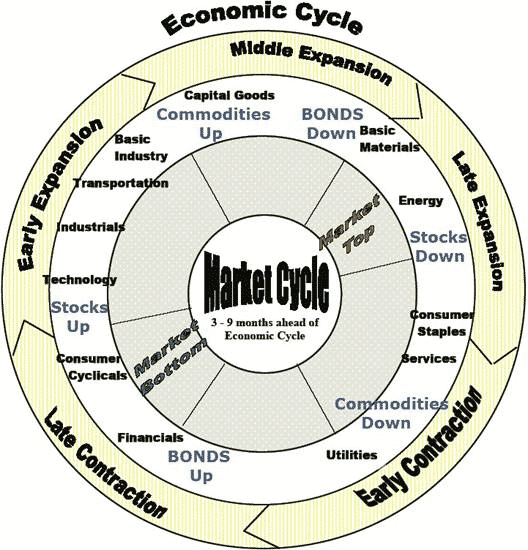Description
The U.S. Sector strategy allocates dynamically between four long U.S. sector sub-strategies. Each of the four long sub-strategies use different momentum and mean reversion criteria
Due to the low correlation of these strategies, the combination creates a strategy with a considerably higher Sharpe Ratio than a simple sector rotation.
The strategy uses SPDR sector ETFs, but you can replace these with the corresponding sector ETFs or futures from other issuers.
US sectors have historically been good for trend following systems because each sector usually over or under performs for long periods at a time due to longer lasting economic cycles and not just short-term market fluctuations.
The economy itself is not a linear stable system, but swings between periods of expansion (growth) and contraction (recession). This results in a series of market cycles which are visualized in the following picture.

Source: http://www.nowandfutures.com (Global Business Cycles)
Each market cycle favors different industry sectors. The goal of a good working strategy is to choose the best performing sectors while avoiding or even shorting the worst performing sectors.
You can read the original strategy whitepaper for more details.
Methodology & Assets
U.S. industry sectors ETFs, their corresponding inverse or short sector ETFs and optional futures:
| U.S. Sector | ETF | Inverse (leverage) | Globex Futures |
| Materials | XLB | SMN (-2x) | IXB |
| Energy | XLE | ERY (-3x) | IXEe |
| Financial | XLF | SKF (-2x) | IXM |
| Industrials | XLI | SIJ (-2x) | IXI |
| Technology | XLK | REW (-2x) | IXT |
| Consumer Staples | XLP | SZK (-2x) | IXR |
| Real Estate | XLRE | SRS (-2x) | - |
| Utilities | XLU | SDP (-2x) | IXU |
| Health Care | XLV | RXD (-2x) | IXV |
| Consumer Discretionary | XLY | SCC (-2x) | IXY |
Statistics (YTD)
TotalReturn:
'Total return is the amount of value an investor earns from a security over a specific period, typically one year, when all distributions are reinvested. Total return is expressed as a percentage of the amount invested. For example, a total return of 20% means the security increased by 20% of its original value due to a price increase, distribution of dividends (if a stock), coupons (if a bond) or capital gains (if a fund). Total return is a strong measure of an investment’s overall performance.'
Which means for our asset as example:- Compared with the benchmark SPY (101.1%) in the period of the last 5 years, the total return of 53.6% of US Sector Rotation Strategy is lower, thus worse.
- During the last 3 years, the total return is 22.3%, which is smaller, thus worse than the value of 82.2% from the benchmark.
CAGR:
'The compound annual growth rate (CAGR) is a useful measure of growth over multiple time periods. It can be thought of as the growth rate that gets you from the initial investment value to the ending investment value if you assume that the investment has been compounding over the time period.'
Applying this definition to our asset in some examples:- Compared with the benchmark SPY (15.1%) in the period of the last 5 years, the compounded annual growth rate (CAGR) of 9% of US Sector Rotation Strategy is lower, thus worse.
- During the last 3 years, the annual return (CAGR) is 7%, which is smaller, thus worse than the value of 22.3% from the benchmark.
Volatility:
'Volatility is a statistical measure of the dispersion of returns for a given security or market index. Volatility can either be measured by using the standard deviation or variance between returns from that same security or market index. Commonly, the higher the volatility, the riskier the security. In the securities markets, volatility is often associated with big swings in either direction. For example, when the stock market rises and falls more than one percent over a sustained period of time, it is called a 'volatile' market.'
Applying this definition to our asset in some examples:- The 30 days standard deviation over 5 years of US Sector Rotation Strategy is 11.6%, which is lower, thus better compared to the benchmark SPY (17.1%) in the same period.
- Compared with SPY (15.5%) in the period of the last 3 years, the historical 30 days volatility of 9% is lower, thus better.
DownVol:
'Risk measures typically quantify the downside risk, whereas the standard deviation (an example of a deviation risk measure) measures both the upside and downside risk. Specifically, downside risk in our definition is the semi-deviation, that is the standard deviation of all negative returns.'
Which means for our asset as example:- The downside volatility over 5 years of US Sector Rotation Strategy is 8.3%, which is lower, thus better compared to the benchmark SPY (11.8%) in the same period.
- During the last 3 years, the downside risk is 6.3%, which is lower, thus better than the value of 10.3% from the benchmark.
Sharpe:
'The Sharpe ratio was developed by Nobel laureate William F. Sharpe, and is used to help investors understand the return of an investment compared to its risk. The ratio is the average return earned in excess of the risk-free rate per unit of volatility or total risk. Subtracting the risk-free rate from the mean return allows an investor to better isolate the profits associated with risk-taking activities. One intuition of this calculation is that a portfolio engaging in 'zero risk' investments, such as the purchase of U.S. Treasury bills (for which the expected return is the risk-free rate), has a Sharpe ratio of exactly zero. Generally, the greater the value of the Sharpe ratio, the more attractive the risk-adjusted return.'
Applying this definition to our asset in some examples:- Looking at the risk / return profile (Sharpe) of 0.56 in the last 5 years of US Sector Rotation Strategy, we see it is relatively lower, thus worse in comparison to the benchmark SPY (0.73)
- During the last 3 years, the risk / return profile (Sharpe) is 0.49, which is smaller, thus worse than the value of 1.27 from the benchmark.
Sortino:
'The Sortino ratio, a variation of the Sharpe ratio only factors in the downside, or negative volatility, rather than the total volatility used in calculating the Sharpe ratio. The theory behind the Sortino variation is that upside volatility is a plus for the investment, and it, therefore, should not be included in the risk calculation. Therefore, the Sortino ratio takes upside volatility out of the equation and uses only the downside standard deviation in its calculation instead of the total standard deviation that is used in calculating the Sharpe ratio.'
Applying this definition to our asset in some examples:- The downside risk / excess return profile over 5 years of US Sector Rotation Strategy is 0.78, which is smaller, thus worse compared to the benchmark SPY (1.07) in the same period.
- Compared with SPY (1.91) in the period of the last 3 years, the downside risk / excess return profile of 0.7 is lower, thus worse.
Ulcer:
'The ulcer index is a stock market risk measure or technical analysis indicator devised by Peter Martin in 1987, and published by him and Byron McCann in their 1989 book The Investors Guide to Fidelity Funds. It's designed as a measure of volatility, but only volatility in the downward direction, i.e. the amount of drawdown or retracement occurring over a period. Other volatility measures like standard deviation treat up and down movement equally, but a trader doesn't mind upward movement, it's the downside that causes stress and stomach ulcers that the index's name suggests.'
Using this definition on our asset we see for example:- The Ulcer Index over 5 years of US Sector Rotation Strategy is 6.51 , which is smaller, thus better compared to the benchmark SPY (8.42 ) in the same period.
- During the last 3 years, the Ulcer Ratio is 4.89 , which is higher, thus worse than the value of 3.57 from the benchmark.
MaxDD:
'Maximum drawdown is defined as the peak-to-trough decline of an investment during a specific period. It is usually quoted as a percentage of the peak value. The maximum drawdown can be calculated based on absolute returns, in order to identify strategies that suffer less during market downturns, such as low-volatility strategies. However, the maximum drawdown can also be calculated based on returns relative to a benchmark index, for identifying strategies that show steady outperformance over time.'
Using this definition on our asset we see for example:- Compared with the benchmark SPY (-24.5 days) in the period of the last 5 years, the maximum reduction from previous high of -16.4 days of US Sector Rotation Strategy is higher, thus better.
- Looking at maximum drop from peak to valley in of -11.7 days in the period of the last 3 years, we see it is relatively larger, thus better in comparison to SPY (-18.8 days).
MaxDuration:
'The Drawdown Duration is the length of any peak to peak period, or the time between new equity highs. The Max Drawdown Duration is the worst (the maximum/longest) amount of time an investment has seen between peaks (equity highs). Many assume Max DD Duration is the length of time between new highs during which the Max DD (magnitude) occurred. But that isn’t always the case. The Max DD duration is the longest time between peaks, period. So it could be the time when the program also had its biggest peak to valley loss (and usually is, because the program needs a long time to recover from the largest loss), but it doesn’t have to be'
Using this definition on our asset we see for example:- Compared with the benchmark SPY (488 days) in the period of the last 5 years, the maximum time in days below previous high water mark of 507 days of US Sector Rotation Strategy is larger, thus worse.
- Looking at maximum days below previous high in of 270 days in the period of the last 3 years, we see it is relatively larger, thus worse in comparison to SPY (87 days).
AveDuration:
'The Average Drawdown Duration is an extension of the Maximum Drawdown. However, this metric does not explain the drawdown in dollars or percentages, rather in days, weeks, or months. The Avg Drawdown Duration is the average amount of time an investment has seen between peaks (equity highs), or in other terms the average of time under water of all drawdowns. So in contrast to the Maximum duration it does not measure only one drawdown event but calculates the average of all.'
Using this definition on our asset we see for example:- Compared with the benchmark SPY (120 days) in the period of the last 5 years, the average time in days below previous high water mark of 150 days of US Sector Rotation Strategy is greater, thus worse.
- During the last 3 years, the average days under water is 106 days, which is larger, thus worse than the value of 21 days from the benchmark.
Performance (YTD)
Allocations and holdings shown below are delayed by one month.
Register now to get the current trading allocations.
Allocations ()
Returns (%)
- Note that yearly returns do not equal the sum of monthly returns due to compounding.
- Performance results of US Sector Rotation Strategy are hypothetical and do not account for slippage, fees or taxes.
- Results may be based on backtesting, which has many inherent limitations, some of which are described in our Terms of Use.
